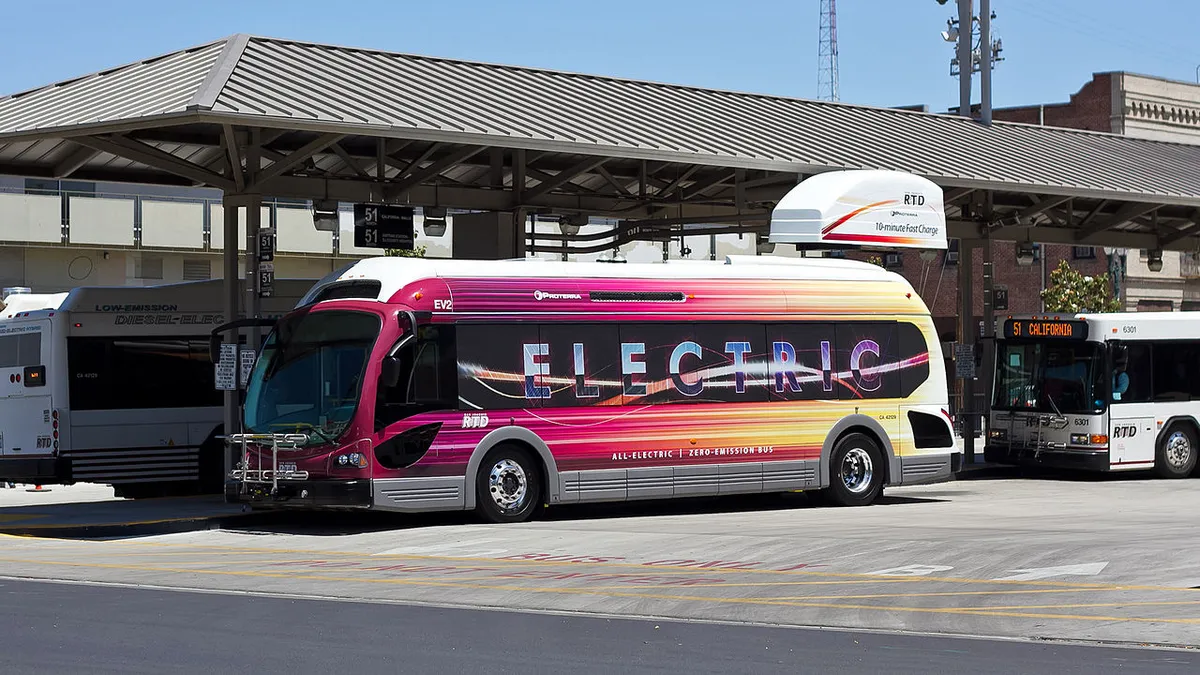Dive Brief:
-
Municipal bus fleets across the world are expected to transition to 80% electric by 2040, according to Bloomberg New Energy Finance research on global electric vehicle (EV) trends.
-
Despite the high cost to purchase e-buses and build out their charging infrastructure, BNEF forecasts operational savings by 2019 for many charging configurations, compared to the total cost of ownership of conventional diesel buses.
-
The California Air Resources Board (CARB) expects to vote in September on a regulation to transition 100% of the state's public transit to zero emissions by 2040. Last week, the San Francisco Municipal Transit Authority passed a resolution to convert its bus fleet to 100% electric by 2035.
Dive Insight:
More electric vehicles means more demand for power, which can create complications for the grid, but is a welcome boost for utilities. Focus has been on the potential for consumer EV growth, but bus fleets are a significant potential market that could drive more charging infrastructure.
"Scalable, interoperable charging infrastructure will be important for achieving 100% zero-emission fleet goals," Lauren Burke, spokeswoman for CalZEV and vice president of Mission Control Communications, told Utility Dive via email.
This summer, CARB plans to put out official regulatory language for its proposal to electrify all transit by 2040, including interim dates for purchasing e-buses. The vote, expected in September, could lead to another historic clean energy mandate, after the California Energy Commission passed a requirement May 9 for rooftop solar on all new residences after 2020.
Industry stakeholders and environmental groups supporting the transition to e-buses launched a formal coalition on Wednesday focused on supporting CARB’s Innovative Clean Transit initiative called Californians for Zero-Emission Vehicles (CalZEV).
As the CalZEV initiative grows, it will reach out to more charging station companies and other industry stakeholders to support the CARB proposal, according to Hannah Goldsmith, project manager at California Electric Transportation Coalition (CalETC), a separate industry coalition that joined CalZEV.
Charging station developer EVgo has already joined CalZEV and other companies developing electric transit infrastructure are indirectly involved with the coalition. For example, Greenlots is a member of CalETC.
The state's transit industry has expressed concerns about transitioning to zero-emission buses. The initial investment involves costly buses and battery systems, as well as charging infrastructure.
CalZEV, as well as its industry member CalETC, have been working with the California Transit Association, "trying to strike a balance that will make sense for the transit agencies, but also achieve the state's air quality targets and climate change goals," Goldsmith told Utility Dive in a phone interview.
The Transit Association was not available for comment but shared the draft of the counterproposal that was sent to CARB last month. The counterproposal focuses on early deployment funding beginning in 2020, establishing commitments from individual municipal transit agencies provided that barriers to deploying e-buses — such as high electricity rates, infrastructure availability and funding — have been resolved.
Many of the supporters of the e-bus transition also support continuing to allow transit agencies to access zero-emission incentive funding after any future compliance requirements kick in, Goldsmith added. This has not been generally allowed by CARB, according to Goldsmith, but the transit agencies have a difficult time operating profitably while keeping public transportation costs affordable.














